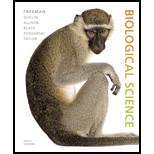
Concept explainers
Why are N, P, and K considered limiting nutrients?
a. They tend to be found in extremely low levels within plants.
b. Their presence limits the availability of micronutrients.
c. Their availability tends to limit plant growth.
d. They limit the amount of cation exchange taking place in roots.
Introduction:
The concept of limiting nutrients explains that the nutrient that is in short supply relative to the other nutrients will exhaust first and will limit the growth of the plant cells.
Answer to Problem 1TYK
Correct answer:
The availability of nutrients tends to limit the growth of the plant.
Explanation of Solution
Explanation/Justification for the correct answer:
Option (c) is given that availability of limiting nutrients tends to limit the growth of a plant. Nitrogen is an essential nutrient and a key element in the growth of the plant. Phosphorus aids in the transfer of energy from sunlight to the plants and regulates the growth of the plant. Potassium regulates the closing and opening of stomata and the production of ATP in plants. If these nutrients are exhausted, the plant growth will be affected. Hence, Option (c) is correct.
Explanation for incorrect answers:
Option (a) is given that limiting nutrients are found at very low levels in the plants. Nitrogen, phosphorus, and potassium are macronutrients and these are present in large quantity. So, it is a wrong answer.
Option (b) is given that presence of limiting nutrients limits the availability of micronutrients. Micronutrients or trace elements are iron, boron, chlorine, magnesium, zinc, and copper. The presence of macronutrients does not affect the levels of micronutrients. So, it is a wrong answer.
Option (d) is given that limiting nutrients limit the cation exchange occurring in the plants. Limiting nutrients do not interfere with the exchange of cations that is occurring in the roots. So, it is a wrong answer.
Hence, options (a), (b), and (d) are incorrect.
Nutrients are necessary for the growth and metabolism of the plant. Nitrogen, potassium, and phosphorus are crucial for the plant growth as they are the limiting nutrients, but are macronutrients. They do not exhibit their effect on limiting the availability of micronutrients and the exchange of cations in the roots of plants.
Want to see more full solutions like this?
- Which statement best explains the relationship between the amount of sunlight a plant receives and the flow of energy into and out of the plant system? A An increase in the amount of sunlight adds more energy to the system and increases the rate of photosynthesis. B An increase in the amount of sunlight removes energy from the system and decreases the rate of photosynthesis. C A decrease in the amount of sunlight removes energy from the system and increases the rate of photosynthesis. D A decrease in the amount of sunlight adds more energy to the system and decreases the rate of photosynthesis.arrow_forwarddescribe the symptoms of nutrient deficiency in plants.arrow_forwardName five species of legumes. Which nutrient is especially abundant in legumes? Why are their root nodules important?arrow_forward
- Give some examples of plant macronutrients and their sourcesarrow_forwardHow may a plant respond to severe heat stress?(A) by reorienting leaves to increase evaporative cooling(B) by creating air tubes for ventilation(C) by producing heat-shock proteins, which may protect theplant’s proteins from denaturing(D) by increasing the proportion of unsaturated fatty acidsin cell membranes, reducing their fluidityarrow_forward(a) define micro and macro nutrients in plant and give any three names of each? (B) write the function and deficiency symptoms of nitrogen and iron in plant?arrow_forward
- If human beings were the last component in this food chain, what would be the consequences of reduced nutrient supply to plants?arrow_forwardWhy do desert plants that live in very hot and dry conditions have stomata? a. To allow for transpiration b. To allow for gas exchange c. To allow for the release of excess heat d. Both a and b are correct.arrow_forwardAnimals typically use fats in adipose tissues for longterm energy storage, whereas plants use starch in roots. How do animals benefit from using fat? How do plants benefit from using starch? Name two plants that storeenergy for many years. How long is long-term storage for these species? What two plant parts often use fats and why? Storage tissue in enlarged roots is vascularized. How is that important to the plant?arrow_forward
- What is the process by which a plant obtains nutrition for itself? What is the process through which animals and plants transform food into energy?arrow_forwardWhich of the following may stimulate the growth of the roots in plant cuttings? Select one: a. The use of auxins. b. A decrease in soil minerals. c. A decrease in enzymes. d. The use of endocrine secretions.arrow_forwardExperiment to test how one of the following variables impacts the growth of Brassica rapa: Water, Nutrient Availability, and Herbivory 1) Be thorough, how would you set up an experiment of Brassica rapa? For example, if you plan to decrease the amount of water given to your plants how you would like to do this? If you plan to increase nutrients, think about whether you want to do this once or weekly. If you plan to simulate herbivory, think about how you will do this and how much leaf tissue you want to remove. 2) What variables will be controlled during your experiment? In other words, what variables will be the same across the two groups?arrow_forward
